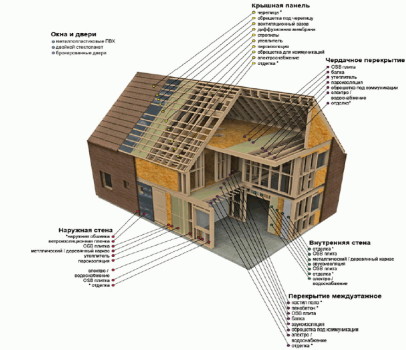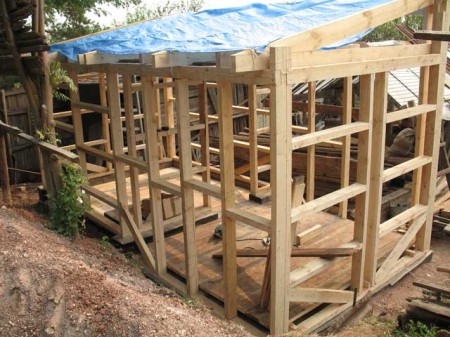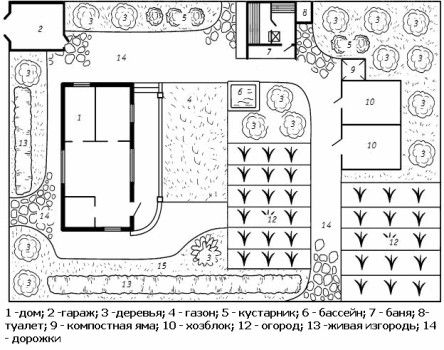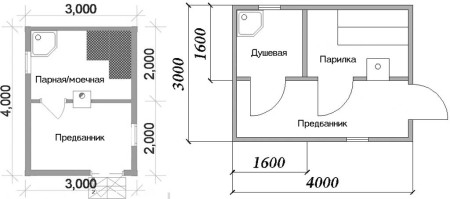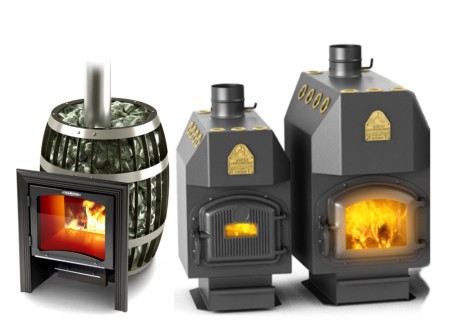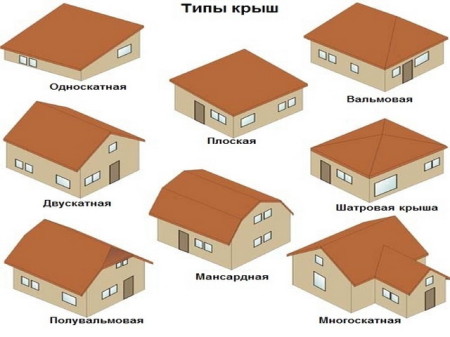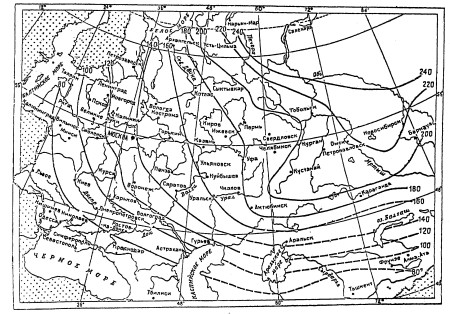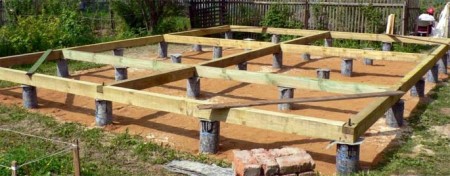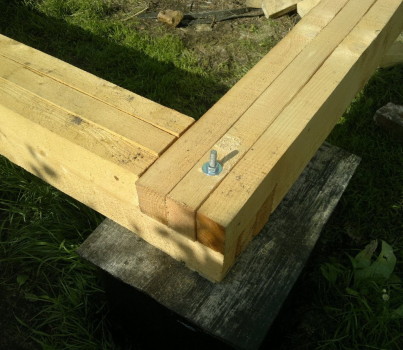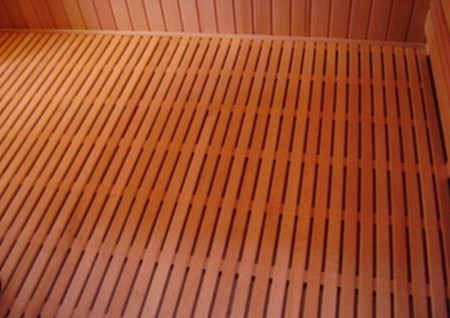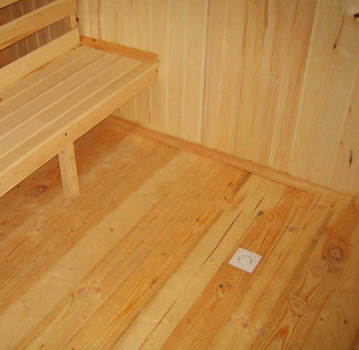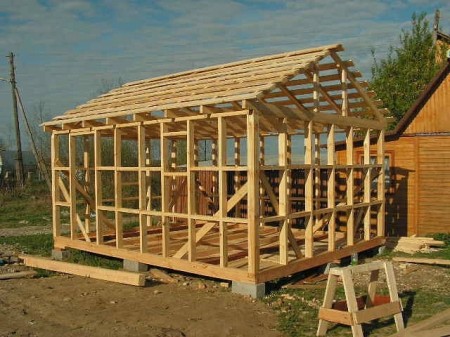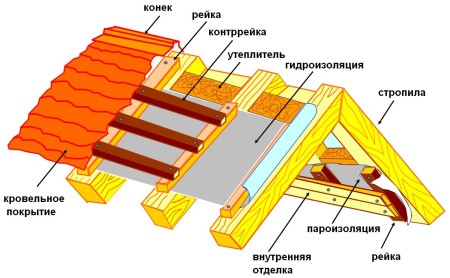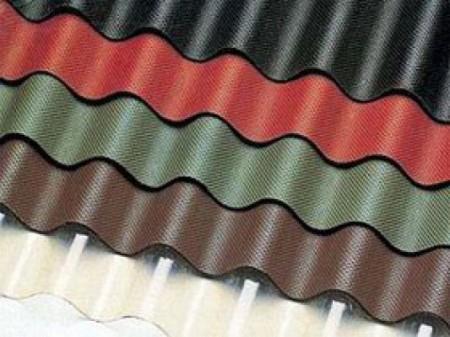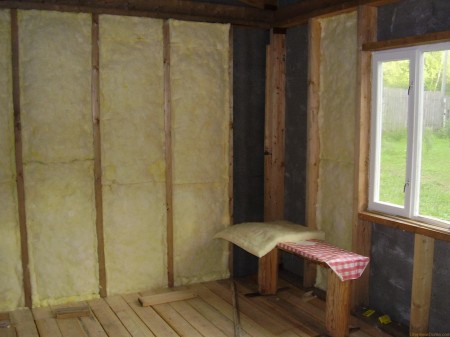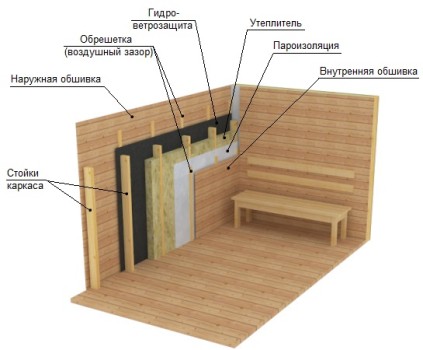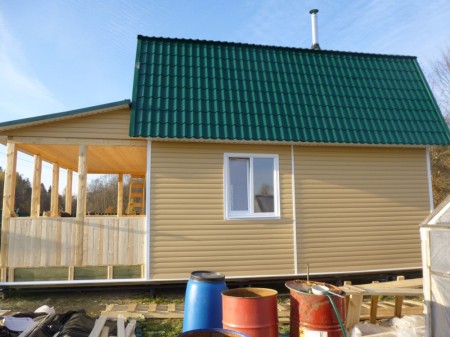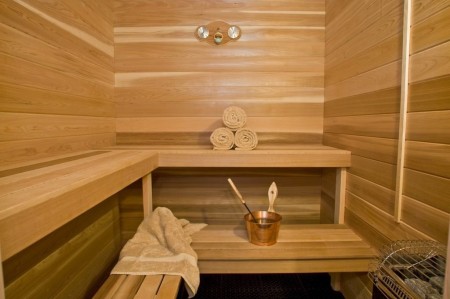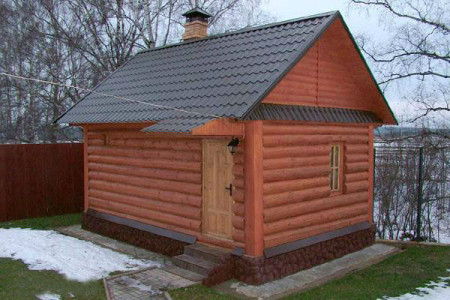Frame sauna is just a budget option for those who do not have enough funds to build a bath of bricks, logs or timber, or simply do not have the patience for months to wait for the end of work. The construction of frame houses does not require the use of special equipment and extensive experience in the field of construction, and modern decoration materials will be able to give an unprepossessing building an attractive appearance.
Content
- 1 What is the frame construction
- 2 Stages of construction of a skeleton bath
- 2.1 choice of the location of the bath
- 2.2 project selection
- 2.3 foundation equipment
- 2.4 bottom harness equipment
- 2.5 flooring equipment
- 2.6 erection of a skeleton and the equipment of the top harness
- 2.7 roof erection
- 2.8 arrangement of waterproofing, thermal insulation and vapor barrier
- 2.9 execution of cladding and finishing
What is the frame construction
Frame buildings belong to easily constructed structures that are built quickly, with minimal use of construction equipment. Despite the fact that buildings on this technology have been erected in some countries for about five hundred years, it has been widely used by us not so long ago, and the use of new materials has made the frame construction a modern trend in construction.
The technology of frame construction consists in the fact that earlier a light supporting frame is constructed from wood and now also from metal, which is lined on both sides with wood, sandwich panels, plywood, OSB plates, cement chipboards and other materials. Between the inner and outer shells is placed a layer of insulation, which is basalt and mineral wool, expanded polystyrene, polyurethane foam, etc. Light and at the same time, a strong wooden frame allows you to build a building of 2, 3 and even 4 floors, and the frame of metal - and higher. In principle, the erection of columnar foundation, installation of floors, ceilings and roofs is the same as in the construction of bathhouses of a different type.
Frame prefabricated buildings have many advantages, as well as a number of shortcomings.
Advantages of frame buildings:
- relative ease of erection of the building;
- short construction time;
- no need for competent drawings and expensive materials;
- relatively small weight of the building, therefore, no need to use an expensive heavy foundation;
- the minimum material consumption and, consequently, the cost of frame construction is much lower than the construction of brick or brick baths;
- minimum shrinkage and because of this low probability of damage to the building;
- relatively long operation life of the structure, although less than brick;
- good heat preservation in the room;
- faster heating of the bath compared to brick or paving because of good thermal insulation;
- less wood consumption for warming up the steam room;
- the possibility of year-round construction;
- the ability to remove a large part of the equipment inside the wall.
Disadvantages of frame buildings:
- high fire hazard, as the frame houses are often built of natural wood;
- for construction, inexpensive materials that can release hazardous substances to living organisms are most often used;
- the need for more thorough heat and vapor insulation in comparison with other types of baths;
- less strength of the structure compared to the baths made of bricks or timber;
- low security of the construction from the actions of intruders.
Given all the pros and cons, it should be noted that the construction of a skeleton bath with their own hands is a good solution for people who want to save on materials and at the same time build a quality bath.
Stages of construction of a skeleton bath
choice of the location of the bath
When drafting, account should be taken of the relief of the site, the distance to the buildings, the places of supply and discharge of water, the points of connection of electricity. It is advisable to place the bath on a certain elevation to simplify the drainage of water. If the sauna is attached to existing buildings, it will facilitate connection to existing communications. It is necessary to decide whether it is worthwhile to equip the bath with sewerage, if it is available on the site, or else it will be necessary to dig a foundation pit and equip a drain pit. It is necessary to know that in the ground with a high level of groundwater the drainage pit is not equipped. It will not be superfluous to consult with the owners of neighboring sites before starting the construction, so that later all sorts of disputable issues do not arise.
project selection
At present, very popular in private construction is frame construction. Projects of wireframe baths, as well as estimates of materials for frame construction in large quantities are available on the Internet. Of these, you can pick up suitable ones and rework them for specific operating conditions.
Depending on the wishes of the owner of the site, its financial possibilities, the size of the plot and other factors, the bath can include a different number of rooms: from large baths with a lot of rooms of various purposes to a small budget bath. Therefore, in the first place it is important to determine the amount that can be allocated for the upcoming construction.
Without a steam room and dressing room bath can not be, however, from experience it is known that without a shower it is also difficult to do. For an inexpensive sauna, a minimal set of rooms will be a steam room, a combined waiting room with a rest room and a shower room. If the area of the bath allows, you can equip the vestibule where you can leave shoes and outer clothing.
When calculating the dimensions of premises it is worth considering that for a comfortable stay of visitors in a steam room for one person should account for not less than 1 m 2, in the shower room - 1,2 m 2. When choosing the height of the room, it is taken into consideration that the hot air always rises, so at a ceiling height above 210 cm it will be difficult to achieve a quality steam in the steam room. In addition, in the steam room it is not recommended to install windows, as they are channels of heat leakage. If you still can not do without windows, it is desirable to install an energy-saving glass unit, and it should be placed as low as possible.
Heating of the air for the steam room is carried out by a stove-heater. There are different types of furnaces: stone, brick, cast iron, steel. It should be borne in mind that, for example, stone and brick furnaces occupy a lot of space, so they should be mounted in large areas. In addition, furnaces made of stone and bricks have a significant weight and for their installation, it is necessary to specially prepare the foundation. For a small and inexpensive frame sauna it is possible to recommend a steel stove-heater, affordable at a price, small in size, relatively light, easy to operate, however, successfully fulfilling its functions. On sale there is a huge selection of furnaces of the most varied shapes and sizes. The original looks like a stove with a remote furnace and a glass door that allows you to watch the fire.
Each owner of the bath should understand that the bath is an object of increased fire hazard. When installing the oven, protection must be carried out in accordance with the manufacturer's recommendations. In addition, before the firebox, it is necessary to put a tile or metal sheet that will help prevent ignition from falling sparks and coals. If the furnace and its furnace are placed in different rooms, then the wall between them must be made of incombustible materials, or make a non-combustible part of the wall. Since the heat from a strongly heated stove can lead to a fire, then a part of the wall around the stove also needs to be laid out of bricks. The openings in the ceiling for the chimney must also be equipped with non-flammable thermal insulation.
Any building must be covered with a roof, and absolutely opposite requirements are imposed on it. It can withstand heavy loads from snow and wind and at the same time should not be heavy, so that it can withstand the construction. There are roofs of single-pitched, double-sloped, multi-slope, etc. Each type has its advantages and disadvantages.
One-run is the simplest, for its erection a minimum of materials is required, it has low sail, but there is no possibility to make an attic space, on its surface snow will accumulate. Gable and multi-slope roofs, on the contrary, are difficult to manufacture, require much more materials, have high sail, but under such roofs there is sufficient volume for attic equipment, which, moreover, is an additional thermal insulation. In addition, the construction with a gable or multi-slope roof has a more attractive appearance.
foundation equipment
The foundation equipment begins with its marking on the terrain. Direct angles can be easily set using a triangle with a 3: 4: 5 aspect ratio, the so-called "Egyptian triangle".
There are several types of foundations: slab (monolithic), belt, pile, columnar. Each foundation has its own spheres of application, depending on the type of soil, the load and the nature of the erected building. Since the skeleton sauna has a small weight compared to other buildings, it is not necessary to make a heavy foundation, for such a bath a simple columnar is suitable. In addition, for easy construction, there is no need to connect individual poles with reinforced concrete bridges, so the amount of work and consumption of construction materials is significantly reduced.
The column foundation consists of buried support pillars, which are installed in the corners of the building and in the places of greatest load. The distance between the poles can be in the range from 1.5 m to 2.5 m, the depth of penetration is below the freezing level of the soil by about 20 cm. The freezing point of the soil can be determined from the map.
The foundation pillars can be made of a variety of materials: wood (oak, larch, cedar), reinforced concrete, clay brick, stone. For light structures, such as skeleton baths, asbestos-cement pipes with metal fittings, filled with mortar, are successfully used. Pits for such a foundation can be made very quickly with a hand drill. First it is necessary to pour the solution into the pipe by about a third and raise it so that the leaked solution fills the bottom of the pit. After this, you should top off the solution, compact the mixture to eliminate voids, and insert the armature inside the pipe.
Before the end of concreting, it is necessary to install fasteners, with which the lower strapping will be fixed on the foundation. To do this, you can insert a long bolt head down into the solution or a long pin with a bent end, also dropped into the concrete mix. After the solution solidifies with these fastening elements, the lower trim bar will be fixed to the foundation.
There are also other ways of fixing the strapping, for example, using anchor bolts or clamps. Further work on assembling the frame is carried out only after the base has completely solidified.
bottom harness equipment
The main building material for the construction of frame houses are sawn timber. The wood must be calibrated, well dried, thoroughly treated with antiseptics and flame retardants to protect it from rotting and fire. Experts advise using such types of wood as aspen, linden, larch, which have low thermal conductivity.
Strapping is a very important part of the structure, it can be lower and upper. The lower one is laid on the foundation and the entire construction of the structure rests on it, and the upper one is the connecting element for the walls and the support for the roof. For a quality installation of the lower strapping the beam must be laid strictly horizontally, the height difference should not be more than ± 1 cm, and all angles are equal to 90 °. In small limits, the difference can be eliminated by laying a roofing material under the bundle bar. To check the angles, you need to measure the diagonals of the strapping - they should be the same.
For the lower strapping, a thicker beam is usually used than for a building frame, for example, with a size of 100 × 100 or 150 × 150. The bar in the harness can be joined together by sampling in a half-tree and fixing with spikes or nails. To prevent decay of wood between the foundation and the binding, a layer of roofing material must be laid. Not too much will be a layer of insulation. The strap must be securely fixed on the foundation, for which it is necessary to drill holes in the uneven bars for bolts or studs mounted in the foundation, and tighten them with nuts with locknuts. To ensure that the nuts do not cut into the wood, they usually have wide washers under them. It is also possible to fasten the harness with anchor bolts or clamps. In the bars of the lower strapping will be cut logs, intended for flooring.
flooring equipment
Floors in a skeleton bath can be leaking and non-flowing. The flowing structures are arranged in such a way that slots are left between the boards for draining the water. The floors have a simple device, do not contain a layer of thermal insulation, so in winter, the feet will be cold and such a bath can only be used seasonally. In addition, floor boards due to damp relatively quickly decay. Of the merits of the sexes can only be called their low cost.
If you plan to operate the sauna all year round, then for premises intended for washing, it is necessary to have reliable and warm non-draining floors. They are more expensive, durable, more difficult to manufacture, carefully insulated from moisture, have a heat and vapor barrier. To drain the water, the floors must have a slope towards the drain.
In the frame bath floor boards are not recommended to paint or varnish, because when heated they can release harmful to human health substances.
erection of a skeleton and the equipment of the top harness
The frame of the structure constructed according to the described technology is a bearing structure. For angular racks, you can use a 100 × 100 bar, the value of intermediate racks is 100 × 50, that is, a layer of thermal insulation can fit inside the frame. The distance between the columns must first be measured with the dimensions of the thermal insulation material and the cladding, and at the same time take into account that the openings for future windows and doors should also not fall on vertical racks.
On the lower trim, first vertical vertical angles, then intermediate vertical posts, are installed. Fastening of the racks can be performed with the help of cuts in the harness or use metal perforated fasteners and screws. The position of the racks should be strictly vertical and controlled at all stages of the assembly. At the time of installation, the racks are leveled and held in a vertical position by means of temporary braces. The frame can also be assembled on the ground and raised in assembled form.
After installing all the corner and intermediate racks, the frame is covered with boards, OSB plates, cement chipboards or other materials that are attached to the posts using self-tapping screws. To impart rigidity to the frame, permanent braces are installed at the end of the assembly, while temporary ones are dismantled. Over the vertical racks, the bars of the upper strapping are fixed and fixed with the help of metal corners and self-tapping screws, and overlapping boards are laid on the top bandage.
roof erection
When erecting a frame house, the rafters of a multi-slope roof are easier to assemble on a template on the ground, then lift and mount above. On the last elements of structures on the ground, it is worth marking up the OSB sheets, which will later be clad with a pediment. To make the roof, you can use boards 105 × 50, it will rely on ridge run and Mauerlat.
For a roof, as well as for walls, a thorough steam, heat and waterproofing is necessary. The vapor barrier material is fixed to the inside of the rafters by staples or galvanized nails, and is connected with adhesive tape to ensure the sealing. On the top of the vapor barrier between the rafters is laid a layer of thermal insulation, then from the outside of the rafters - waterproofing. Roofing is fixed to the rafters through the crate, which ensures the uniformity of the load on the rafter system.
There is a wide choice of roofing materials: shingles, ruberoid, slate, Euroshield, corrugated board, ceramic tiles, copper, slate and others. Frame sauna is a relatively inexpensive construction, and therefore, to cover the roof with expensive materials does not make sense. By the ratio of price / quality of all roofing materials, one of the first places is the Euro-sphere. It is characterized by low weight, low price, long service life, a variety of colors and ease of installation.
arrangement of waterproofing, thermal insulation and vapor barrier
Frame sauna is quickly heated, but not able to keep the heat. Since the frame has a small thickness and wood of this size is not able to prevent heat leakage, mineral wool, fiberglass, expanded polystyrene, polyurethane foam, foam isole and other materials having a low heat transfer coefficient are widely used as the thermal insulation for frame structures.
Thermal insulation materials are placed inside the frame, between the outer and inner lining and should occupy the entire interior space. If, for some reason, a pass was obtained in the thermal insulation, this place will be the channel for the heat leakage from the room.
Skeleton baths, especially in the cold season, tend to form a large amount of condensate and therefore require very careful protection from condensation. To ensure a vapor barrier from the inside of the frame, it is recommended to place a vapor barrier film with a layer of foil. In the steam room and shower room, where there is very high air humidity, foil vapor barrier is required. It will be able to protect the wood and the layer of thermal insulation from moisture, as well as allow you to keep the heat in the steam room longer. The film can be attached to wooden structures with a stapler, and the joints of individual parts must be glued with adhesive tape or with a self-adhesive foil film. The ruberoid is not recommended for steam insulation because of the release of harmful substances and odor at high temperatures.
To the frame building does not absorb moisture in wet weather, a layer of waterproofing is placed between the heater and the external skin. As a waterproofing can be used pergamine, special vapor barrier films.
As a result, the wall of the skeleton bath will consist of the following elements:
- finishing material;
- interior trim;
- a layer of vapor barrier;
- layer of thermal insulation;
- a layer of waterproofing;
- external cladding;
- outer lining.
When performing work on heat and vapor barrier, it is necessary to know that the insulation of the ceiling is given no less importance than the walls, as hot moist air rises precisely to the ceiling. For this purpose, mineral wool, expanded clay, and other materials can be used. The ceiling, as well as the walls, must be protected by a layer of vapor barrier. If it is planned to use foam for heat insulation, it must be taken into account that it is a combustible material, besides, it generates toxic substances when heated, so it is not suitable for warming the steam room. Polyfoam is a favorite habitat for rodents, which usually happens very much in country and suburban areas.
In order to quickly and efficiently remove moisture from the premises, it is not superfluous to use forced ventilation in the bath.
execution of cladding and finishing
Advantage of frame construction is that a variety of finishing materials can be used in finishing baths, as a result of which it can be given an appearance both original and traditional. The outer part of the building can be finished with lining, siding, decorative tiles, with boards or simply plastering. Using a planed block house block will transform the skeleton bath into chopped bath. In order to save the external wall can be sewed not by lining of wood, but by plastic lining or profiled sheets with a polymer or paint coating applied.
For interior decoration of walls and ceiling from inexpensive materials, you can also use a lining or boards.
When performing work on the inner lining, it is necessary to fill the vertical struts with vertical strips so that a gap of 20-30 mm remains between the vapor barrier and the layer of external finishing material for ventilation. If this is not done, the condensing moisture will lead to rapid decay of the wood.
Facing both external and internal is placed horizontally, which will help increase the rigidity of the entire structure.
When you follow all the recommendations, the bath should turn out to be warm and cozy, despite the fact that not a very large amount was spent on its construction. For those who want to simplify the construction process as much as possible, but at the same time to assemble it by their own hands, specialized companies offer original designers for every taste: ready sets of lumber already fitted in sizes, cladding, sets of fasteners, technical documentation for self-assembly and etc. One has only to be prepared for the fact that the cost of such a designer will be slightly higher than that of materials selected independently.



